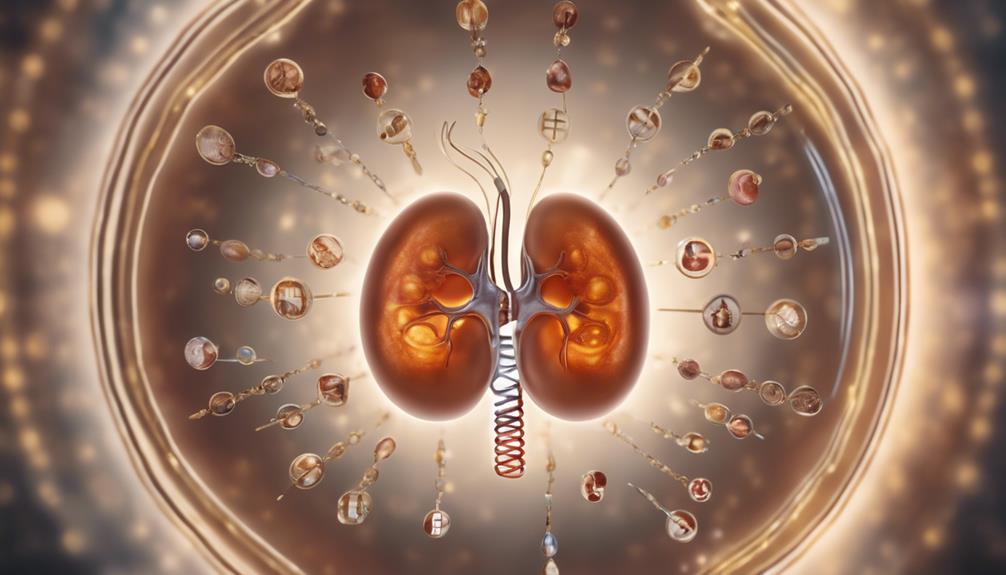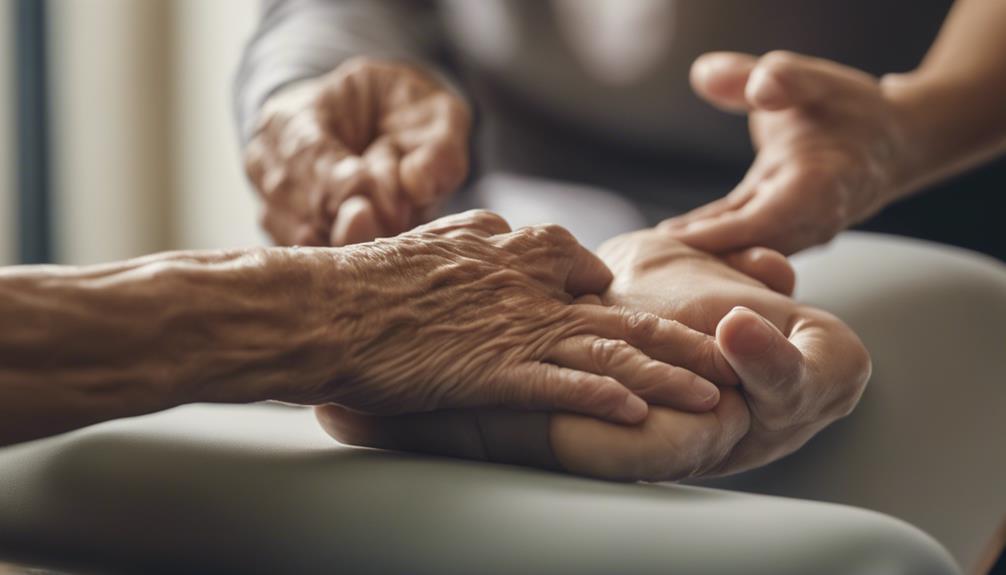What Is Nail Patella?

Nail Patella Syndrome (NPS) is a genetic disorder impacting nail, knee, and elbow development due to mutations in the LMX1B gene. It presents with musculoskeletal anomalies like hypoplastic patellae and limited elbow extension, alongside potential renal and ophthalmic complications. Nail abnormalities, including koilonychia, are common diagnostic indicators. Skeletal features such as underdeveloped kneecaps and elbow deformities contribute to diagnosis. Treatment options range from non-surgical interventions like physical therapy to surgical corrections for skeletal abnormalities and kidney complications. Understanding NPS involves a multidisciplinary approach. Further insights await those interested in the complexities of this condition.
Key Takeaways
- Nail Patella syndrome (NPS) is a genetic disorder affecting nails, knees, elbows, and kidneys.
- It results from mutations in the LMX1B gene crucial for limb development.
- NPS presents with nail abnormalities, skeletal deformities, and renal complications.
- Diagnosis involves genetic testing to confirm LMX1B mutations.
- Treatment includes non-surgical and surgical options to manage symptoms and improve quality of life.
Genetic Basis of Nail Patella

Rare genetic mutations in the LMX1B gene have been identified as the primary cause of Nail Patella syndrome (NPS). These mutations affect the development of nails, knees, elbows, and pelvis, leading to the characteristic symptoms associated with NPS. Understanding the genetic basis of NPS is crucial for early diagnosis and intervention to improve the quality of life for individuals affected by this condition.
LMX1B is a transcription factor that plays a vital role in the development of limbs and the formation of various tissues in the body. Mutations in the LMX1B gene disrupt normal development, resulting in the abnormalities seen in NPS. Genetic testing can help confirm the presence of these mutations and aid in diagnosing NPS in individuals showing symptoms.
Clinical Manifestations of NPS
Individuals with Nail Patella syndrome (NPS) often present with distinct clinical manifestations that reflect the impact of genetic mutations on various anatomical structures and physiological functions. Common clinical features of NPS include musculoskeletal abnormalities, renal issues, ophthalmic complications, and dermatological manifestations. Here is a table summarizing the clinical manifestations associated with Nail Patella syndrome:
| Clinical Manifestations | Description |
|---|---|
| Musculoskeletal abnormalities | Include hypoplastic patellae, limited elbow extension, iliac horns, and scoliosis. |
| Renal issues | Range from proteinuria and hematuria to end-stage renal disease. |
| Ophthalmic complications | Glaucoma is a common finding in individuals with NPS. |
These manifestations can vary in severity among affected individuals, necessitating a multidisciplinary approach to management. Early detection and intervention are crucial to address the diverse clinical presentations of Nail Patella syndrome effectively.
Nail Abnormalities in NPS

Nail abnormalities in Nail Patella syndrome (NPS) encompass a range of distinctive characteristics that often serve as key diagnostic indicators for this genetic disorder. Individuals with NPS commonly exhibit abnormal nail development, which can present as absent, poorly developed, or dystrophic nails. The nails may appear triangular, small, or discolored, and they may grow slowly or be brittle. Additionally, individuals with NPS may have missing nails (anonychia) or underdeveloped nails (hypoplastic nails), particularly affecting the thumbnails. These nail abnormalities are typically noted at birth or during early childhood and can aid healthcare providers in diagnosing NPS.
Moreover, individuals with NPS may experience koilonychia, a condition where the nails are abnormally thin and concave, resembling a spoon. Koilonychia can be particularly prominent in individuals with NPS and may impact the overall appearance and function of the nails. Understanding these nail abnormalities is crucial for early diagnosis and appropriate management of Nail Patella syndrome.
Skeletal Features of Nail Patella
Skeletal abnormalities are another hallmark of Nail Patella syndrome (NPS), providing additional diagnostic insights into this genetic condition. Individuals with NPS often exhibit skeletal issues such as underdeveloped kneecaps, elbow deformities, and hip irregularities. The patella, or kneecap, is commonly affected in NPS, leading to patellar hypoplasia or aplasia. This can result in instability and pain in the knee joint, impacting mobility and quality of life. Elbow abnormalities, including limited extension or fusion of the elbow joint, are also common in individuals with NPS. Hip dysplasia, where the hip socket is shallow, can lead to hip dislocations and early-onset osteoarthritis.
Furthermore, skeletal anomalies in the hands and feet are prevalent in NPS. These can include missing or improperly formed bones, particularly affecting the thumbs and big toes. These skeletal features, when observed alongside nail abnormalities, help healthcare providers in diagnosing Nail Patella syndrome and differentiating it from other conditions with similar symptoms. Understanding the skeletal manifestations of NPS is crucial for early detection, management, and improving the overall quality of life for individuals affected by this rare genetic disorder.
Renal Involvement in NPS

Renal involvement is a critical aspect of Nail Patella Syndrome (NPS), impacting kidney function and potentially leading to proteinuria. Understanding the implications of renal issues in individuals with NPS is essential for comprehensive management and care. Monitoring kidney function and proteinuria levels can be crucial in the medical management of NPS patients.
Kidney Function in NPS
Impaired kidney function is a common manifestation in individuals with Nail Patella Syndrome (NPS), underscoring the systemic nature of this genetic disorder. Kidney abnormalities in NPS can range from mild proteinuria to more severe conditions like nephrotic syndrome or even end-stage renal disease. The most common renal abnormality observed in NPS is proteinuria, which is the presence of excess protein in the urine. This can be an early indicator of kidney dysfunction and requires close monitoring. Additionally, individuals with NPS may also experience hypertension, which can further impact kidney function. Regular kidney function tests, blood pressure monitoring, and consultations with healthcare providers specializing in nephrology are essential in managing the renal involvement in NPS.
Proteinuria Implications in NPS
Proteinuria, a common renal abnormality in individuals with Nail Patella Syndrome (NPS), serves as a crucial marker for early detection of kidney dysfunction. In NPS, proteinuria results from the leakage of proteins into the urine due to impaired kidney function. Monitoring protein levels in the urine can help healthcare providers assess the severity of kidney involvement in NPS patients. Detecting proteinuria early can aid in implementing interventions to slow down the progression of kidney damage, ultimately improving patient outcomes. Regular screening for proteinuria is essential for individuals with NPS to promptly address any renal issues that may arise. By recognizing proteinuria as a significant indicator of renal impairment in NPS, healthcare professionals can provide timely and targeted care to support these individuals effectively.
Diagnostic Approaches for NPS
Diagnosis of Nail Patella Syndrome involves a comprehensive evaluation of clinical manifestations and laboratory tests to confirm the condition. Clinical features such as absent or underdeveloped nails, skeletal abnormalities, and kidney issues like proteinuria can provide crucial clues for diagnosis. A physical examination may reveal characteristic skeletal deformities such as iliac horns or patellar aplasia. Additionally, laboratory tests play a vital role in confirming the diagnosis. Genetic testing can identify mutations in the LMX1B gene, which is associated with Nail Patella Syndrome. Urinalysis may detect proteinuria, a common renal manifestation in NPS. Imaging studies like X-rays can help visualize skeletal abnormalities, aiding in the diagnostic process. Collaborating with a multidisciplinary team comprising geneticists, nephrologists, orthopedic specialists, and dermatologists is essential for a comprehensive evaluation and accurate diagnosis of Nail Patella Syndrome. Early detection through a thorough diagnostic approach is crucial for initiating appropriate management strategies and improving patient outcomes.
Management of Nail Patella

The management of Nail Patella Syndrome involves a spectrum of treatment options and surgical interventions to address the specific needs of individuals with this condition. Understanding the available treatment modalities and interventions is crucial in providing comprehensive care and improving quality of life for those affected by NPS. By exploring these points in depth, healthcare providers can tailor management strategies to meet the unique requirements of each patient.
Treatment Options Overview
Exploring a variety of interventions and therapies is essential in effectively managing Nail Patella syndrome. Treatment options for Nail Patella focus on addressing symptoms and improving quality of life. Non-surgical approaches include physical therapy to enhance mobility and strength, assistive devices for daily activities, and medications to manage pain and other associated conditions. Occupational therapy can help individuals adapt to challenges in daily tasks due to hand or finger abnormalities. Regular monitoring by healthcare providers is crucial to track progression and adjust treatment plans accordingly. Additionally, lifestyle modifications such as maintaining a healthy diet and weight can support overall well-being. Collaborating with a multidisciplinary team of healthcare professionals can provide comprehensive care and support for individuals with Nail Patella syndrome.
Surgical Interventions Available
For individuals with Nail Patella syndrome, surgical interventions offer targeted approaches to address specific symptoms and improve functional outcomes. Surgical options for Nail Patella may include procedures to correct skeletal abnormalities, such as patellar dislocation or elbow deformities, enhancing mobility and reducing pain. In cases of severe joint degeneration, joint replacement surgeries can be considered to restore functionality and alleviate discomfort. Additionally, surgeries to address kidney complications, such as nephropathy, may be necessary to maintain renal health and overall well-being. It is essential for healthcare providers to carefully assess each patient's unique needs and tailor surgical interventions to optimize outcomes and enhance the quality of life for individuals with Nail Patella syndrome.
Research and Future Perspectives
Advancements in technology and increased collaboration among researchers have paved the way for exciting developments in the field of Nail Patella syndrome, offering hope for improved understanding and potential treatment options in the near future. Recent research efforts have focused on unraveling the genetic mechanisms underlying Nail Patella syndrome, aiming to identify specific genes responsible for the condition. This deeper understanding of the genetic basis of the syndrome could lead to targeted therapies that address the root cause of the disorder.
Furthermore, ongoing studies are exploring novel treatment approaches, including gene therapy and personalized medicine, tailored to individual patients based on their genetic profiles. These cutting-edge interventions hold promise for more effective and personalized management of Nail Patella syndrome, potentially improving patient outcomes and quality of life.
Collaborative initiatives between researchers, healthcare providers, and patient advocacy groups are essential for driving progress in the field and translating research findings into clinical applications. By working together, the scientific community can continue to advance our knowledge of Nail Patella syndrome and pave the way for innovative treatments that benefit those affected by this rare genetic disorder.
Frequently Asked Questions
Can Nail Patella Syndrome Be Prevented Through Genetic Testing?
Genetic testing can reveal the presence of mutations associated with nail patella syndrome. While prevention may not be possible, early detection through testing can enable proactive management and interventions to address symptoms and complications effectively.
Are There Specific Exercises That Can Help Manage Skeletal Features in Nps?
Exercise can help manage skeletal features in NPS. Consult with a healthcare provider or physical therapist to develop a personalized exercise plan. Strengthening exercises focusing on core stability, flexibility, and low-impact activities may be beneficial.
How Can Individuals With NPS Maintain Healthy Kidney Function?
Individuals with NPS can maintain healthy kidney function by staying hydrated, following a balanced diet low in sodium and protein, monitoring blood pressure regularly, and seeking regular check-ups with a healthcare provider for early detection and management of any kidney issues.
Is There a Cure for Nail Patella Syndrome?
Currently, there is no cure for nail patella syndrome. Treatment primarily focuses on managing symptoms and complications to improve quality of life. Individuals with this condition often require ongoing medical care and support from healthcare professionals.
What Advancements Are Being Made in NPS Research for Potential Treatments?
Advancements in NPS research for potential treatments focus on gene therapy, stem cell research, and targeted drug therapies. Collaborative efforts between researchers, clinicians, and patients aim to develop personalized treatment options and improve quality of life for those with Nail Patella Syndrome.




